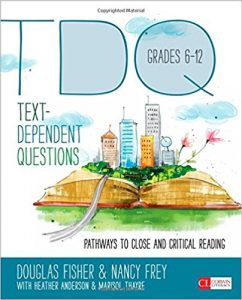Growing Reading Practice

I became an English teacher because I loved to read. My days would be filled studying the works of Hemingway and Fitzgerald–determining the link between a text’s historical setting and its plot, studying symbolism. I was so excited.
But with the adoption of the Common Core State Standards and my training in reading and writing workshops, I realized something. With the CCSS, I was not a teacher of literature; I was a teacher of skills to read literature. I’d like to share two experiences that helped me develop this realization.
More than Summaries
In my first experience, I was several days into an introductory unit on personal narratives. My teaching partner and I chose a Nick Adams story as the text of study. After three days reading the story together as a class (insert groan here), students wrote summaries of the stories.
But these summaries restated words I had used in class to explain key scenes. They did not reference the actual text, and they had no feeling. Each summary was dry in word choice, and the structure was repeated over and over again, across the 120 students who wrote it. It was clear that kids did not engage in the text, nor did I ask them to.
I realized that kids should and can do more with a text than just name its main idea. Second, a better teaching move would have been to model for kids how to read this text to find a main idea.
Observing a Writer’s Craft
The next experience involved a literacy consultant who brought some texts that were so interesting in content and structure, that I had to find a place to use them in my classroom. The consultant shared these texts as mentor texts for middle school informational reading. The texts were news articles and introductions to books, on The New York Times.
As a teacher who has always taught without a textbook, these texts opened my mind to authentic genres and dynamic texts that were rigorous for my grade level. They were also the complete opposite of the dry, formulaic informational essays that I had been reading.
Now I knew that I had texts that were worth reading beyond the main ideas. They had a beauty of language and unique structures that related to the development of their main ideas. I needed to model for kids, then, how to read these texts–to appreciate the word choices, craft decisions, and structures.
Close Reading
I currently work with teachers, and help them choose texts with the rigor expected in the CCSS. These are real-life texts that students can later use as mentor texts for writing.
 I teach close reading strategies for fiction and informational reading. According to Fisher and Frey, “Close reading is an instructional routine in which students are guided in their understanding of complex texts” (2015, p. 1). As an instructional coordinator, I love that Fisher and Frey’s text is offered for grades K-5 and 6-12. Key ideas from the 6-12 text that I have used in classrooms:
I teach close reading strategies for fiction and informational reading. According to Fisher and Frey, “Close reading is an instructional routine in which students are guided in their understanding of complex texts” (2015, p. 1). As an instructional coordinator, I love that Fisher and Frey’s text is offered for grades K-5 and 6-12. Key ideas from the 6-12 text that I have used in classrooms:
- 1st read: What does the text say? By underlining key ideas and details, develop an understanding of the central idea of the text.
- 2nd read: How does the text work? By taking note of vocabulary, craft, and structure, understand why an author uses these moves to enhance the main idea.
- 3rd read: What does the text mean? Consider the bias and purpose of the writing to determine how a reader receives this text.
- 4th read: What does the text inspire you to do? Evaluate the action you will take, having read this text, such as writing or debating.
Reading can be relevant and exciting for students. At the same time, I can teach reading skills, like noticing an author’s craft, and the impact these things have on my reading experience.
A Farewell to Arms may still be my favorite book of all time, and I may read it everyday before I go to bed. But my job as a teacher of English is to help kids learn how to access meaning from any text that they may encounter in their lives.
 Amy Gurney (@agurney_amy) is an ELA and Social Studies Curriculum Coordinator for Walled Lake Schools. She has a Master’s degree from Michigan State University in Educational Administration and is currently pursuing an Education Specialist in Educational Leadership at Oakland University. She is a current Galileo Leader. She worked on the MAISA units of study and has studied reading and writing workshop practice and conducted action research.
Amy Gurney (@agurney_amy) is an ELA and Social Studies Curriculum Coordinator for Walled Lake Schools. She has a Master’s degree from Michigan State University in Educational Administration and is currently pursuing an Education Specialist in Educational Leadership at Oakland University. She is a current Galileo Leader. She worked on the MAISA units of study and has studied reading and writing workshop practice and conducted action research.
